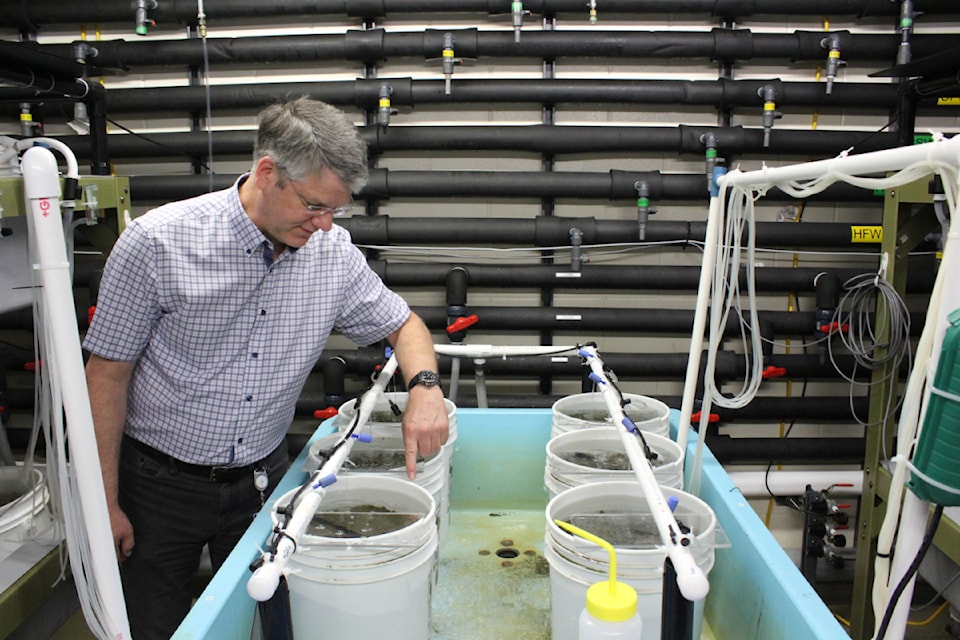As carbon dioxide levels in the oceans climb, researchers at Nanaimo's Pacific Biological Station are trying to breed oysters that can survive in these new conditions and help prevent a shellfish industry collapse.
Tim Green, Vancouver Island University�㽶��Ƶֱ���s Canada research chair in shellfish health and genomics, is working with Department of Fisheries and Oceans researchers Chris Pearce and Clara Mackenzie to breed oysters which can survive higher levels of ocean acidification, as well as identify relevant genomes responsible for the species' survival.
"It's really to make the oyster aquaculture more climate change resistant [and] breeding a better oyster that's more tolerant to increased temperatures and increased acidification levels, so that the industry can be more productive in the future with climate change," Pearce said. "So they can produce more oysters and make more money."
For the project, researchers collected 19 families of oysters from Canada, Washington, Chile and the U.K., a variety intended to mirror the composition of oysters sold in the industry.
The mollusks are then subjected to increased concentrations of carbon dioxide and acidity, while the researchers monitor growth. The successful are then selectively bred. The oysters are currently on their third generation.
While the breeding takes place, Green analyzes samples to identify genes common in successful populations that may be indicative of high ocean acidification resistance, then uses those genomic markers to screen others and discover correlation. Green compared it to screening bulls to produce the best offspring in dairy farms.
"I screen and find what I would call 'selection candidates' [to] continue our program," Green said. "The most important bit for why we do the research is so the shellfish industry in B.C. can take those animals and spawn more and create offspring for B.C. shellfish farms that are now going to have high survival."
Other factors being considered include resistance to high temperatures and bacteria, as well as traits valued in the oyster industry such as fast growth and a good shell colour.
"Oysters and other marine animals are going to get hit by a variety of stressors," Pearce explained. "Increasing temperatures, decreasing oxygen, increasing ocean acidification, so you really have to think about all these factors and how you're going to breed a resistant strain to multiple stressors."
He said the reason the work is being done is to prevent an industry collapse.
"We've seen that in prior years: die-offs of oysters, both cultured oysters and wild oysters, due to heat stress, primarily. When we had the [heat dome] �㽶��Ƶֱ��� billions of animals were killed because of high temperatures."
After the current three-month phase of the project is completed, Green will be doing a thorough analysis of the oysters, examining ways to further improve them. He will then turn his attention to some of the other climate stressors.
"Ocean acidification and climate change is making an impact now �㽶��Ƶֱ��� the general public is being led to believe we need to think about 2050 or 2100," Green said. "A lot of our agriculture and aquaculture industries are struggling with climate change and we need to focus on reducing our CO2 emissions."
Oysters aren't the only mollusks at the Pacific Biological Station's fisheries and oceans climate change and ocean acidification laboratory that researchers are keeping their eyes on.
The Haida First Nation is working with Pearce and Mackenzie on identifying the reasons for fewer baby razor clams joining adult populations on their beaches in recent years.
"They're thinking that maybe climate change has something to do with it, so they're worried about increasing temperatures and how that impacts recruitment of the clams," Pearce explained.
As a result, Pearce and Mackenzie are working with the First Nation using razor clams brought in from Tofino. After a short trial period to ensure the clams remain healthy in the lab, a one-month test will begin in which researchers will decrease oxygen while increasing temperature.
"As you increase the temperature of the water, there's a corresponding dip in dissolved oxygen concentration. The hotter the water, the less oxygen it can hold �㽶��Ƶֱ��� It usually also increases the metabolism and they need even more oxygen because of that increased metabolism," Pearce said. "So there's kind of a double effect there."
He said that similar to the oysters, the end results are expected to show how those aspects of climate change impact growth, survival and genetic expression. Potential mitigation measures will also be tested in the form of aeration.
"We'll test that in the lab scale with the idea [that] in future years if there was any success there we could also test it in the field," Mackenzie said.



